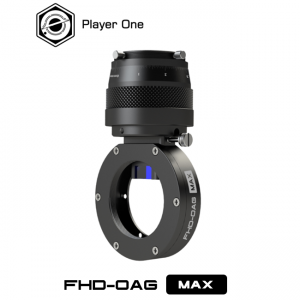The Askar V telescope is the latest offering from Askar that offers a unique optics system as it is equipped with two interchangeable lenses – 60mm and 80mm. The telescope also comes with a wide variety of accessories including a case, reducer, flattener, and extender.
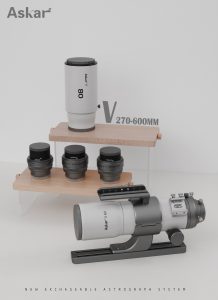 The V60 and V80 objectives both feature a triplet APO design with two ED glass lenses, which deliver very high clarity with negligible chromatic aberration. The V60 native focal ratio is f/6, and the focal length is 360mm. The V80 native focal ratio is f/6.25, and the focal length is 500mm. The Askar V is equipped with three additional accessories that are adjustable to 60mm or 80mm scales through rotation. The rear end of each accessory has M48 and M54 adapters with 2″ built-in filter threads and the back focus is a standard 55mm.
The V60 and V80 objectives both feature a triplet APO design with two ED glass lenses, which deliver very high clarity with negligible chromatic aberration. The V60 native focal ratio is f/6, and the focal length is 360mm. The V80 native focal ratio is f/6.25, and the focal length is 500mm. The Askar V is equipped with three additional accessories that are adjustable to 60mm or 80mm scales through rotation. The rear end of each accessory has M48 and M54 adapters with 2″ built-in filter threads and the back focus is a standard 55mm.
Using the reducer can effectively reduce exposure time and expand the field of view to provide flexibility for imaging. When the reducer is used with the V60 objective lens, the focal length is reduced to 270mm and the focal ratio is increased to f/4.5; when the reducer is used with the V80 objective lens, the focal length is reduced to 384mm and the focal ratio is increased to f/4.8.
The included Askar V telescope flattener improves field curvature, edge quality and reduces aberrations. When used with the 60mm objective lens, the focal length remains 360mm and the focal ratio is f/6, while when used with the 80mm objective lens, the focal length changes to 495mm and the focal ratio becomes f/6.18.
The Askar V extender, when used with the objective lens at the aperture of 60mm, has a focal length of 446mm and the focal ratio is f/7.43. When using the 80mm lens, the focal length is 600mm and the focal ratio is f/7.5. The extender supports both the connection to objective lenses of different apertures and the effective extension of the focal length, allowing clearer images to be captured and more detail to be observed.
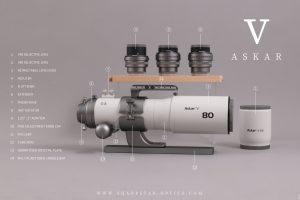 The telescope also comes with Askar’s new scaled 360° rotator and finder base and 1.25” and 2” visual adapters, supporting high-quality visual observation. A multifunctional handle design makes the telescope more portable and easier to connect to vixen style finder base and accessories.
The telescope also comes with Askar’s new scaled 360° rotator and finder base and 1.25” and 2” visual adapters, supporting high-quality visual observation. A multifunctional handle design makes the telescope more portable and easier to connect to vixen style finder base and accessories.
The Askar V telescope V60 mode OTA specifications include:
– Aperture size: 60mm
– Focal length: 360mm
– Focal ratio: f/6
– Objective lens: Triplet air-spaced APO (including two ED glasses)
– Distance from the 2″ adapter to the focal plane with the focuser barrel retracted: 150mm
– Total length (without accessories: 318.5mm
– Total Weight: (including tube rings and dovetail plate): 2.8kg
– Rear-end adapters: 2” adapter, 1.25” adapter
– 60mm lens with +V Reducer: focal length 270mm; f ratio f/4.5
– 60mm lens with +V Flattener: focal length 360mm; f ratio f/6
– 60mm lens with +V Extender: focal length 446mm; f ratio f/7.43
– Rear-end adapter: M54×0.75, M48×0.75 (built-in 2”filter thread)
– Back focus: 55mm (from the M48 adapter)
The Askar V telescope V80 mode OTA specifications include:
– Aperture size: 80mm
– Focal length: 500mm
– Focal ratio: f/6.25
– Objective lens: Triplet air-spaced APO (including two ED glasses)
– Distance from the 2″ adapter to the focal plane with the focuser barrel retracted: 139.7mm
– Total length (without accessories): 411mm (with the dew shield contracted), 479mm (with dew shield extended)
– Total Weight (including tube ring and dovetail): 3.4kg)
– Rear-end adapters: 2” adapter, 1.25” adapter
– 80mm lens +V Reducer: focal length 384mm; f ratio f/4.8
– 80mm lens +V Flattener: focal length 495mm; f ratio f/6.18
– 80mm lens +V Extender: focal length 600mm; f ratio f/7.5
– Rear-end adapter: M54×0.75, M48×0.75 (built-in 2” filter thread)
– Back focus: 55mm (from the M48 adapter)
You can learn more about the Askar V telescope here.
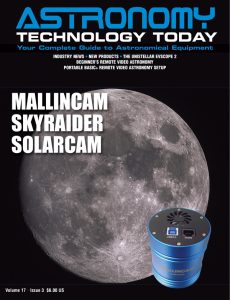
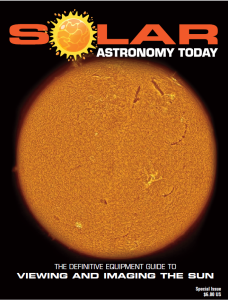 And to make it easier for you to get the most extensive news, articles and reviews that are only available in the magazine pages of Astronomy Technology Today, we are offering a 1-year magazine subscription for only $6! Or, for an even better deal, we are offering 2 years for only $9. Click here to get these deals which only will be available for a very limited time. You can also check out a free sample issue here.
And to make it easier for you to get the most extensive news, articles and reviews that are only available in the magazine pages of Astronomy Technology Today, we are offering a 1-year magazine subscription for only $6! Or, for an even better deal, we are offering 2 years for only $9. Click here to get these deals which only will be available for a very limited time. You can also check out a free sample issue here.
The Sun is more active than it’s been in years and if that’s not enough, we have the Annular Solar Eclipse on October 14, 2023 and the Total Solar Eclipse on April 8, 2024! If you’d like to learn more about the technology behind solar observing, solar imaging and more, you can check out our free publication, “The Definitive Guide to Viewing and Imaging the Sun”. You don’t have to sign up or provide any information, simply click here and enjoy reading!



